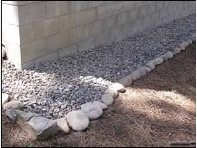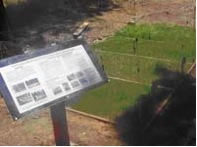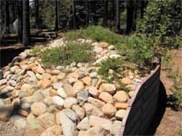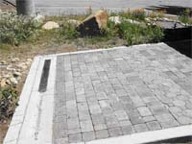 |
April 2010
|
April 2010 // Volume 48 // Number 2 // Ideas at Work // v48-2iw5
North Lake Tahoe Demonstration Garden Teaches About Best Management Practices and Fire Defensible Space
Abstract
Because water quality and wildfire are critical issues at Lake Tahoe, a demonstration garden teaches about best management practices and defensible space, in addition to demonstrating what plants grow in our mountain environment. Extension worked with the local Conservation District to design and build unique displays with interpretive signs that show people options they can use on their properties. All demonstrations comply with requirements for control of nonpoint source pollution and for fire defensible space. The garden's biggest contribution to the community is that it teaches property owners how they can meet multiple environmental objectives in an effective and attractive manner.
Introduction
Lake Tahoe is one of the deepest and clearest high altitude lakes in the world. It is considered a national treasure, yet its famed clarity has decreased from an average of over 100 feet in 1968 to about 70 feet in 2007. This decrease is attributed to nonpoint source pollution from development of property in the lake's watershed.
In addition, most neighborhoods in the Tahoe Basin watershed are built within or adjacent to second growth forests that are susceptible to intense wildfires. Because of fire suppression activities throughout the 20th century, there is abundant dead fuel in most forests to feed catastrophic fires. In June of 2007, the wind-driven Angora Fire destroyed 250 homes in the City of South Lake Tahoe in a single afternoon.
The educational challenge of teaching people how to protect Lake Tahoe with water quality best management practices (BMPs), while implementing effective defensible space practices, is daunting. Although the bistate Tahoe Regional Planning Agency (TRPA) requires all property owners to retrofit structures with BMPs, our 2005 survey of Tahoe Basin residents showed that only 39% knew the meaning of the term.
University of Nevada Cooperative Extension has worked with the TRPA and two local Conservation Districts to offer free publications (Cobourn, et al., 2006) and site evaluations since 2000, but progress is slow. Less than 25% of property owners had implemented BMPs as of 2008. The goal is at least 80% compliance. The TRPA is bolstering its BMP requirements by working with local jurisdictions to include BMP implementation targets in their Storm Water Management Plans and their National Pollutant Discharge Elimination System (NPDES) Permits. These efforts are in turn linked to the Tahoe Total Maximum Daily Load (TMDL) process. The goal of the TMDL is to restore the lake to its former average clarity measurement of 100 feet.
Extension Partners with Local Agencies
University of Nevada Cooperative Extension has worked with local Fire Protection Districts since the late 1980s to teach property owners how to implement defensible space practices. Ed Smith's Living With Fire publications (Smith, 2008) have become well known guides for homeowners on both the California and Nevada shores of Lake Tahoe and throughout much of the West. The 2007 Angora Fire in South Lake Tahoe, CA increased public awareness of the need for defensible space, but well under half of Lake Tahoe residents have created the recommended 30 foot "Lean, Clean and Green Zone" around their homes.
We have learned that if property owners plan for and implement both BMPs and defensible space in an integrated fashion, they can avoid mistakes and produce a more attractive and effective design (Cobourn, 2008). Unfortunately, few homeowners tackle both at once. In 2003, our office began working with the Nevada Tahoe Conservation District and the Board of the North Lake Tahoe Demonstration Garden to create exhibits that would help homeowners see the kinds of landscaping practices that they could use at home.
The Bare Soil Dilemma
There is a seeming contradiction between the need for ground cover to control soil erosion and the need to reduce vegetative fuels near structures. Though local fire chiefs and erosion control experts have worked on compromises and win-win solutions since at least 2001, there is still considerable confusion over this topic in the general public.
Figure 1.
Bare Soil Under a Roof Drip Line
Is Vulnerable to Erosion

Fine sediment is the most serious pollutant in Lake Tahoe, and it comes largely from erosion of disturbed, unvegetated soil. (Figure.1) For this reason, the TRPA requires bare soil to be mulched or vegetated on all developed properties. But after the Angora Fire, public pressure for stronger defensible space measures led to a prohibition of the widespread use of organic mulches within 30 feet of structures. It also led to the requirement for homeowners to rake up fallen pine needles from Jeffrey Pine trees each spring.
Figure 2.
The Area Within Five Feet of
Structures Must Be Noncombustible. Gravel Mulches or Grasses Can Be
Used to Prevent Erosion

Because wood, bark, and pine needle mulches are now discouraged on bare soil close to structures, people must plant more vegetation on their bare soil or cover it with inorganic mulch such as gravel if they are to comply with BMP Retrofit requirements of the TRPA (Figure 2). The 2008 second edition of the Lake Tahoe Basin version of Living With Fire states that people can cover bare soil with "low-growing, irrigated, herbaceous plants, such as lawn, clover, erosion-control grasses, flowers, some ground covers, and succulents, that are recommended for the Lake Tahoe Basin."
Responding to Defensible Space Requirements with New Exhibits
We knew that Extension had created Demonstration Gardens before to teach about BMPs (Obropta, DiNardo, & Rusciano, 2008; Foerster & Barry, 2007)). We proposed new displays of different kinds of grasses that would grow well in the Tahoe Basin and provide defensible space benefits. The Demonstration Garden Board authorized Extension and the Nevada Tahoe Conservation District to select a variety of grasses from the TRPA Recommended Plant List (Cobourn, 2006, Chapter 7) and create demonstration plots in the garden.
Because we had no budget for this project, we contacted potential partners—a local nursery and seed supply company—and found them eager to contribute seed and drip irrigation supplies. Renquist (2005) encourages such partnerships for getting projects started. Eleven plots were prepared in fall of 2007, and grass seed was planted in May of 2008. We also created interpretive signs describing the pros and cons of turf lawns vs. low maintenance erosion control grasses. A subsurface drip irrigation system was installed to allow experimentation with efficient water application practices. All of this work was done by hand by Extension and Conservation District staff and garden volunteers. This new exhibit has received good local press coverage, because it shows property owners how to control erosion while meeting defensible space requirements. (See Figure 3.)
Figure 3.
Various Species of Erosion
Control Grasses Have Been Planted. Interpretive Signs Discuss Pros
and Cons of Turf Versus Erosion Control Grasses

Showing How to Control Erosion on Steep Slopes
The TRPA requires structural stabilization along with vegetation to control erosion on slopes of over 50% steepness (calculated as a rise of 1 foot over a 2-foot run). Because the garden does not have any slopes over 20%, we decided to create three mounds to illustrate various kinds of slope stabilization measures. Each mound is about 5 feet high. The back of each mound demonstrates a retaining wall, and the front illustrates different slope treatments. Mound 1 has a curving rock breastwall in back and an erosion control blanket and irrigated grasses on the 50% slope on the front. Mound 2 has a curved TREX retaining wall in back and rock "rip rap" with abundant herbaceous vegetation on the front. Mound 3 shows an interlocking concrete block retaining wall in back and three vegetated terraces on the slope in front (Figure 4).
Figure 4.
Slope Stabilization Mounds Show
Use of Terracing, Low Retaining Walls, Rock Rip Rap, and Vegetation
for Slopes over 50% Steepness


Several interpretive signs explain the design and function of the six different slope stabilization modes named above. With Board Members who are Master Gardeners caring for the plantings, these three displays are among the most attractive in the garden.
Infiltration of Runoff
Though the Lake Tahoe Basin has relatively dry summers, the 20-year, 1-hour summer thunderstorm is viewed as the design storm for BMPs. The TRPA requires property owners to infiltrate all runoff from a storm of 1 inch of rain in 1 hour before it leaves the lot. Because many homes at Lake Tahoe are built on slopes, this is a very difficult standard to meet, but the storm drains in local streets are not designed to capture or treat runoff from private properties.
The Demonstration Garden has an attractive gazebo that is 15 feet square. The runoff from the roof of this structure is directed into a variety of infiltration systems. On one side, the water from the roof falls into a drip line infiltration trench. On another side, it is directed by a gutter to a rectangular infiltration trench that is 36 inches deep and filled with prefabricated water storage units wrapped in filter fabric and covered with gravel. Obropta, DiNardo, & Rusciano (2008) describe another infiltration system that is growing in popularity, especially in the wetter parts of the country, called a "rain garden."
Figure 5.
Demonstration Driveway Shows
Ways to Capture and Convey Runoff from Driveways into Shallow
Infiltration Systems Before It Reaches the Street

On a third side, the water falls onto a demonstration driveway sloping away from the gazebo. The driveway demonstrates various pavement options such as paver stones and pervious concrete. Because driveways often receive roof runoff as well as creating their own runoff, this display allows us to demonstrate ways to capture the runoff before it reaches the street (Figure 5). We have installed a channel drain near the foot of the driveway, which conveys the runoff to a shallow, rock-lined infiltration basin (Figure 6). Again, interpretive signs explain these systems to residents who visit the garden.
Figure 6.
Shallow Infiltration Systems
Include Underground Vaults and Above Ground Basins Such as This One

The Garden as an Educational Venue
For several years, the Nevada Tahoe Conservation District has organized "Green Thumb Thursdays." These are a series of lectures at the garden offered by local experts on a variety of topics. In 2004, I organized our annual BMP training for local contractors nearby. For the outdoor hands-on session in the afternoon, the contractors split into groups and helped construct the slope stabilization mounds (Figure 7).
Figure 7.
Contractors Learn How to
Stabilize Steep Slopes with a Block Retaining Wall

Since then, I have worked with a local interagency group called the Parasol Community Collaboration Environment Team to offer a public workshop each year just before the Independence Day holiday. In 2007 and 2008, we emphasized the importance of installing both defensible space and BMPs. We offered a "live burn" demonstration in the parking lot to show how rapidly various building materials can be ignited by a small fire nearby. This demonstration was presented by the local fire district and by colleagues Susie Kocher and Steve Quarles from University of California Cooperative Extension. In addition to viewing the burn, over 150 participants toured the garden to view all the exhibits, including the defensible space around the gazebo and the garden tool shed.
Conclusion
The North Lake Tahoe Demonstration Garden is a work in progress. We have energetic Master Gardener volunteers who have worked on the garden since its inception in 1992. The garden is centrally located on the campus of Sierra Nevada College at the corner of Tahoe Boulevard and Country Club Drive in Incline Village, Nevada. The many scientists who study the problems of wildfire and water pollution in the Tahoe Basin agree that every property owner must design and manage his or her landscape appropriately in order to solve these problems. Year by year, the residents of Incline Village and nearby communities are becoming aware of this attractive and informative educational resource.
References
Cobourn, J., Carlos, W., Christopherson, J., Donaldson, S., Johnson, W., Post, R., Skelly, J., & Smith, E. (2006). Home landscaping guide for Lake Tahoe and vicinity. Reno, NV. University of Nevada Cooperative Extension Educational Bulletin, EB 06-01. Retrieved September 24, 2008 from: http://www.unce.unr.edu/publications/files/nr/2006/eb0601.pdf
Cobourn, J. (2008). Combine defensible space and best management practices (BMPs). Reno, NV. University of Nevada Cooperative Extension Fact Sheet, FS-08-26. Retrieved October 1, 2008 from: http://www.unce.unr.edu/publications/files/nr/2008/fs0826.pdf
Foerster, J. W., & Barry, S. G. (2007). Seeking environmental stewardship one garden at a time. Journal of Extension [On-line], 45(1) Article 1IAW5. Available at: http://www.joe.org/joe/2007february/iw5.php
Obropta, C. C., DiNardo, M. F., & Rusciano, G. M. (2008). The demonstration rain garden. Journal of Extension [On-line], 46(2) Article 2TOT3. Available at: http://www.joe.org/joe/2008april/tt3.php
Renquist, S. B. (2005). Finding hidden partnerships to create a teaching garden. Journal of Extension [On-line], 43 (5) Article 5IAW4. Available at: http://www.joe.org/joe/2005october/iw4.php
Smith, E. (2008). Living with fire, A guide for homeowners, Lake Tahoe Basin, Second Edition. Reno, NV. University of Nevada Cooperative Extension Special Publication, SP-06-11. Retrieved September 24, 2008 from: http://www.unce.unr.edu/publications/files/nr/2006/sp0611.pdf




